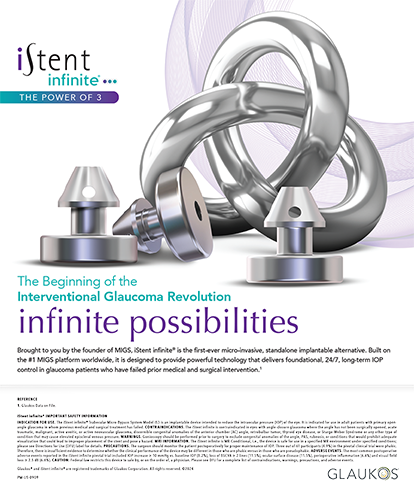
YES
Andrew M.J. Turnbull, BM, PGCertMedEd, PGDipCRS, CertLRS, FRCOphth
Aside from some keen advocates, before the COVID-19 pandemic, the use of immediately sequential bilateral cataract surgery (ISBCS) was largely limited to the private sector and occasional special circumstances (eg, patients requiring general anesthesia and deemed to be at increased anesthetic risk due to medical comorbidities) in the UK National Health Service. Since the pandemic began, however, the popularity of ISBCS has surged in this country. ISBCS is now recommended by the Royal College of Ophthalmologists in appropriate situations because the approach reduces the amount of contact between patients and health care practitioners and allows surgical volume to be maintained while avoiding overcrowding and respecting social distancing requirements. Aside from COVID-19 considerations, ISBCS offers many other advantages over delayed sequential bilateral cataract surgery (DSBCS).
ADVANTAGES FOR PATIENTS
No. 1: Faster visual rehabilitation. Patients can obtain new spectacles and complete their visual recovery sooner than after DSBCS.
No. 2: Avoidance of anisometropia between surgeries. Anisometropia increases the risk of falls due to impaired depth perception. For patients with high preoperative refractive errors, ISBCS prevents anisometropia-related problems.
No. 3: Less time off work. ISBCS requires patients to take time off work and avoid certain activities for only one period versus two separate periods with DSBCS.
No: 4: Less time dependent on the support of family, friends and/or caregivers. This is an important consideration for patients who require assistance with the instillation of eye drops or other activities after surgery.
ADVANTAGES FOR OPHTHALMOLOGISTS
No. 1: ISBCS is more time efficient and permits a higher volume of surgery. Once the routine of ISBCS is established, it takes less OR time to perform one bilateral case compared to two unilateral cases. This means more eyes can be treated on a standard operating list.
No. 2: ISBCS is more cost-effective and allows more patients to be seen. By treating both eyes of a patient on the same day, only one preoperative assessment, surgical visit, and postoperative review are ordinarily required. This releases capacity for new patients to be treated.
ADVANTAGES FOR SOCIETY
No. 1: Fewer visits to the hospital or clinic. The benefits of fewer visits during the COVID-19 pandemic are obvious. Reducing the number of visits and associated travel also reduces the carbon footprint of cataract surgery and has an indirect impact on traffic safety.
No. 2: ISBCS improves capacity and alleviates the follow-up backlog. By halving the number of appointments required for each patient with bilateral cataracts, ISBCS frees up valuable capacity for patients who need follow-up care for chronic, sight-threatening conditions such as glaucoma. There is a substantial backlog of these individuals in many health care systems.
ARGUMENTS AGAINST ISBCS
Despite its advantages in appropriately selected cases, ISBCS remains controversial, and many ophthalmologists oppose it. The following section explores the reasons for the opposition and offers solutions and reassurance to those considering ISBCS.
No. 1: Risk of bilateral endophthalmitis. It is crucial that different batches of consumables, equipment from separate sterilization cycles, and intracameral antibiotics be used for each eye. In one study, the risk of unilateral endophthalmitis after ISBCS was lower than after unilateral surgery, presumably because more stringent protocols were adopted for ISBCS.1 In the same study, the risk of bilateral endophthalmitis after ISBCS was one in 92,000. In most reported cases of bilateral endophthalmitis, deviation from recommended protocols increased the risk of infection and cross-contamination.2
No. 2: More complex, expensive infrastructure is required to ensure that separate batches of consumables and different sterilization cycles for equipment are available. Establishing the infrastructure requires an initial investment, but it is simple to maintain once established within a department.
No. 3: Risk of bilateral surgical complications. Cases of high surgical complexity are usually excluded from ISBCS, although at the surgeon’s discretion. Surgery on the second eye can be rescheduled if a complication occurs on the first eye.
No. 4: Risk of bilateral cystoid macular edema. Patients at increased risk of cystoid macular edema (CME) may be deemed ineligible for ISBCS if desired. CME is readily treatable, however, and prophylactic topical NSAIDs may be used in higher-risk cases. I find that many patients’ vision with pseudophakic CME is better than when they had a dense cataract.
No. 5: No opportunity for refinement of the second eye’s refractive outcome. The risk of significant refractive surprises is low with the use of modern biometry and IOL formulas; refining the refractive outcome of the second eye has only a limited role.3 If a patient has complex anatomy or demanding requirements, performing DSBCS remains an option.
No. 6: Patients who undergo ISBCS delay surgery on the first eye of other patients. This is an ethical conundrum. If ISBCS is adopted as standard, however, the magnitude of the problem decreases over time as more patients become bilaterally pseudophakic and operating lists become more efficient.
No. 7: ISBCS has an adverse impact on training. Routine ISBCS should be performed by an experienced surgeon, which reduces the pool of straightforward cases suitable for trainees. Not all patients, however, need or are suitable candidates for ISBCS, so they remain available for training. Ideally, ISBCS patients should be assigned to higher-volume service lists, which would leave training lists with more unilateral cases.
CONCLUSION
ISBCS offers many advantages to patients, ophthalmologists, and society. Drawbacks can be mitigated with careful service design and case selection. ISBCS will never be appropriate for all patients, but it should be permissible and offered routinely to suitable candidates.
1. Friling E, Johansson B, Lundström M, Montan P. Postoperative endophthalmitis in immediate sequential bilateral cataract surgery: a nationwide registry study. Ophthalmology. 2022;129(1):26-34.
2. Chen MY, Qi SR, Arshinoff S. Bilateral simultaneous postoperative endophthalmitis (BSPOE): review of cases reported over the past 50 years. J Cataract Refract Surg. Published online December 10, 2021. doi:10.1097/j.jcrs.0000000000000875
3. Turnbull AMJ, Barrett GD. Using the first-eye prediction error in cataract surgery to refine the refractive outcome of the second eye. J Cataract Refract Surg. 2019;45(9):1239-1245.

NO
Florian T.A. Kretz, MD, FEBO
ISBCS has become common practice in many settings. I predict, however, that current drawbacks will prevent ISBCS from becoming a routine offering anytime soon.
COMPARISONS TO CORNEAL REFRACTIVE SURGERY
Immediately sequential surgery has become the norm for corneal refractive procedures such as LASIK. First, a flap is created in each eye. Next, excimer laser ablation is performed on the first eye. If a problem arises with the eye, surgery on the second eye may be postponed. The LASIK flap can be lifted and laser ablation performed at a later date.
With laser-assisted ISBCS, both eyes first undergo laser treatment. The remainder of the cataract procedure is then performed on the first eye. Here is where the similarities with corneal refractive surgery end. Once an eye has undergone laser treatment, lens extraction must be performed. Otherwise, endogenous uveitis may develop. If a complication such as rupture of the posterior capsule occurs in the first eye, cataract surgery still must be completed on the second eye. This is far from ideal. An argument can be made that laser cataract surgery is not performed at a high volume worldwide or that complications such as I have described are rare, but a legitimate concern remains.
OTHER CONSIDERATIONS
Refractive outcomes. Many IOL formulas allow users to refine the calculation for the second eye by entering postoperative results from the first eye. This can be helpful in challenging situations such as when the cornea is extremely flat or biometry measurements are difficult to obtain. ISBCS eliminates the opportunity to refine the refractive outcome of the second eye.
Mix-ups. Two sets of information and two IOLs are required for ISBCS. This increases the risk of mix-ups such as implanting the wrong IOL.
Cross-contamination. ISBCS presents the risk of cross-contamination. The surgeon and staff must treat each eye as if it is a separate patient, and the OR must be resterilized in between eyes. Every instrument, medical device, and solution comes from a different load to guard against cross-contamination. Processes must be established and adhered to, and storage capacity for all consumables (eg, IOLs, OVDs, single-use instruments) must be adequate to fulfill the demands of ISBCS.
Cystoid macular edema. Perhaps the most frequent complication of cataract surgery is postoperative cystoid macular edema, which is usually detected 3 to 6 weeks after surgery. It can be argued that the risk of bilateral cystoid macular edema is greater with ISBCS than with DSBCS. If, however, less than 3 weeks typically elapses between surgery on the first and second eyes, then the risk should be pretty much the same.
Candidacy. The most important issue in ISBCS may be identifying suitable candidates. ISBCS can reduce the cost burden on health care systems around the globe, hasten patients’ visual rehabilitation, and eliminate anisometropia during the period between cataract procedures. Some surgeons maintain that the most appropriate candidates for ISBCS are patients who are elderly and/or disabled. Aren’t these same individuals considered to be at increased risk of postoperative infection, inflammation, and blunt trauma due to eye rubbing?
Reimbursement. Economics, unfortunately, factor into the debate over ISBCS. I operate in three different locations in Germany. At one, I may be fully compensated for bilateral cataract surgery if at least 24 hours elapse between procedures. At the other two, the required interval is 21 days. In both scenarios, I am reimbursed for the treatment of only one eye.
CONCLUSION
I offer ISBCS to suitable patients. To my mind, the real problem with routinely offering ISBCS does not lie with the patient or surgery. It instead lies with the reimbursement situation and, on a more personal side, with the center and surgeon. Good organization, the establishment of and adherence to standard operating procedures, and a well-maintained quality management system help to eradicate many of the possible risk factors associated with ISBCS. The objection that remains is a financial one; sadly, the influence of economics on ophthalmology practices continues to grow.




